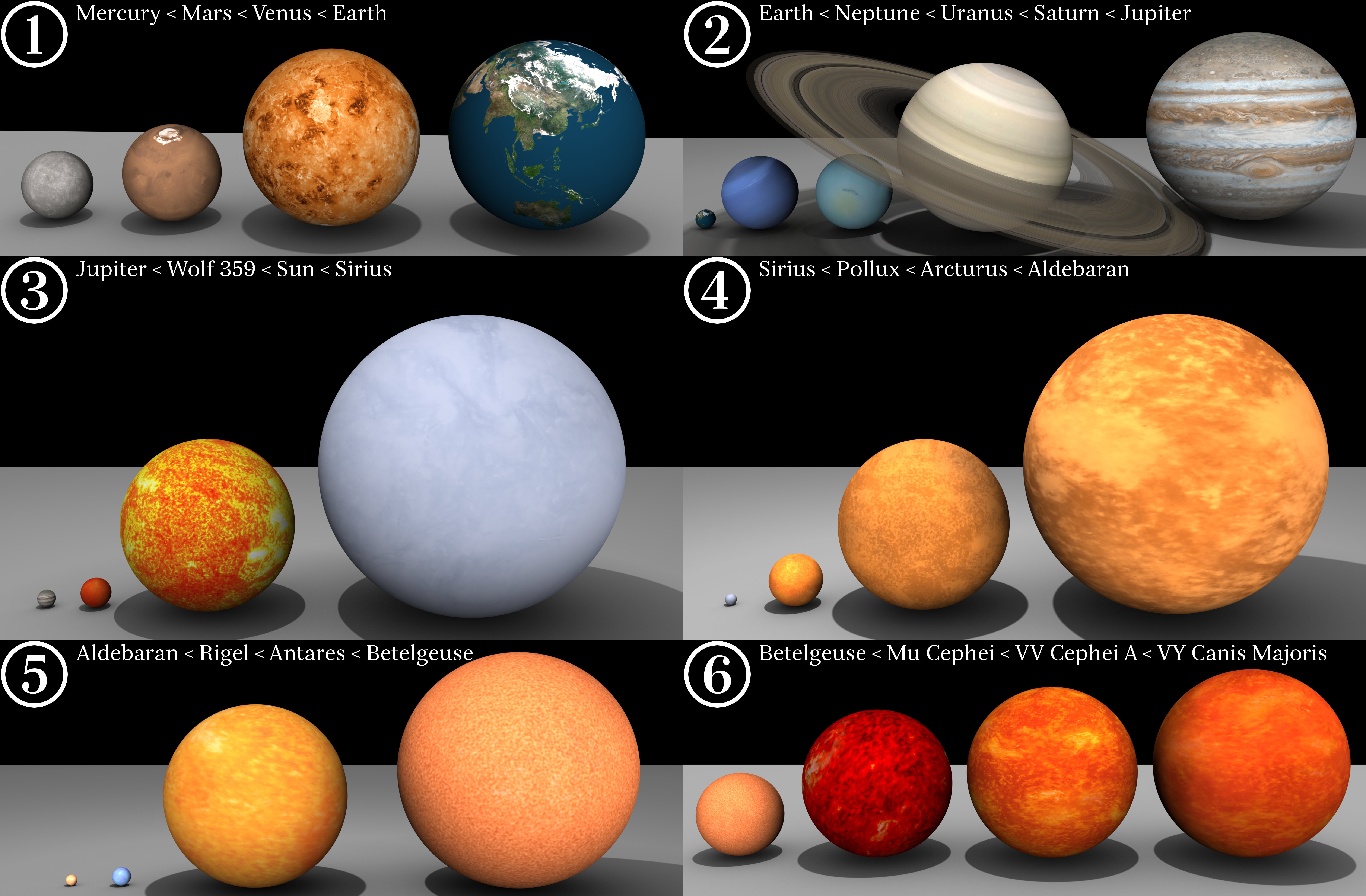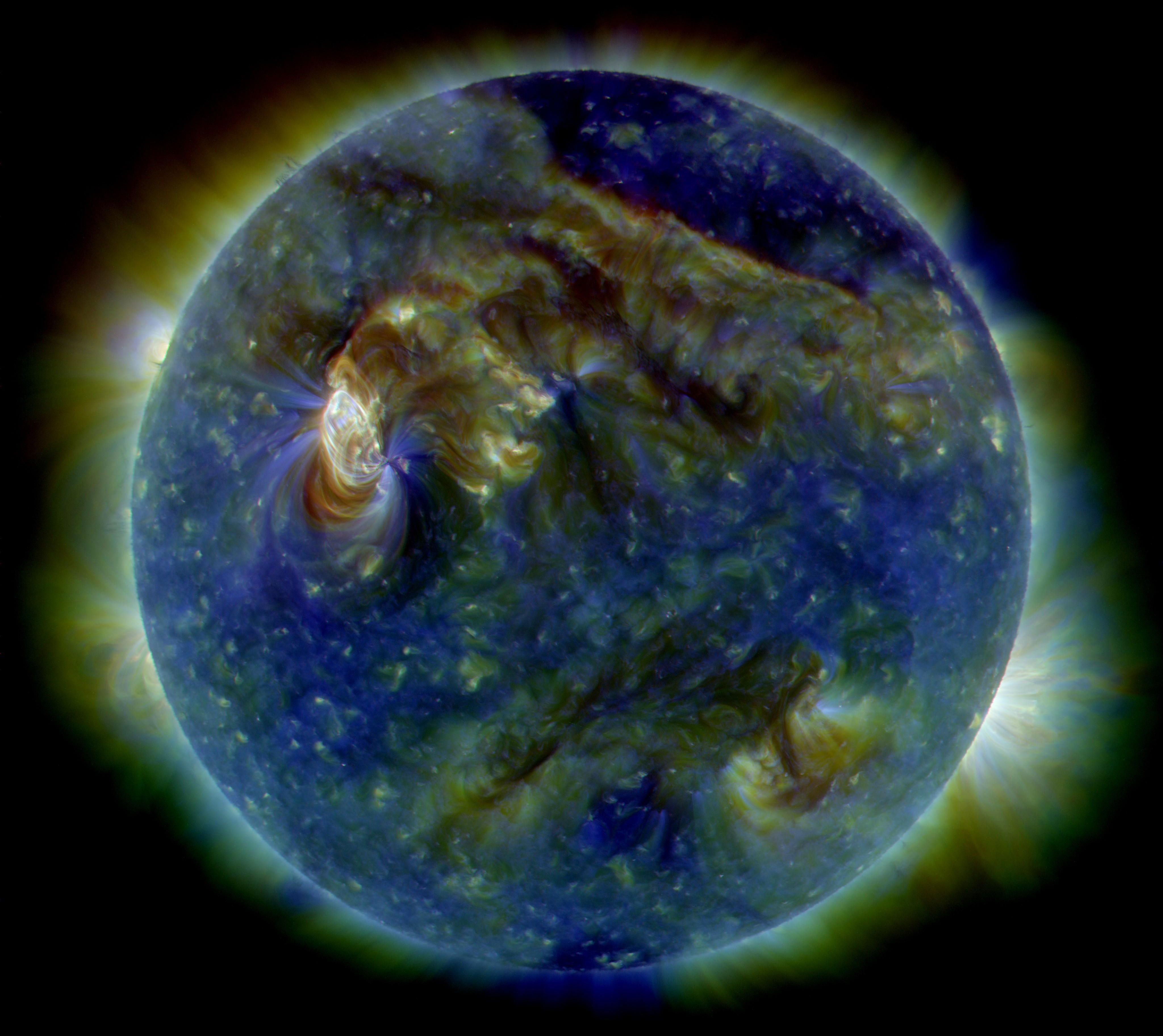|
Canis Major
Canis Major is a constellation in the southern celestial hemisphere. In the second century, it was included in Ptolemy's 48 constellations, and is counted among the 88 modern constellations. Its name is Latin for "greater dog" in contrast to Canis Minor, the "lesser dog"; both figures are commonly represented as following the constellation of Orion the hunter through the sky. The Milky Way passes through Canis Major and several open clusters lie within its borders, most notably M41. Canis Major contains Sirius, the brightest star in the night sky, known as the "dog star". It is bright because of its proximity to the Solar System. In contrast, the other bright stars of the constellation are stars of great distance and high luminosity. At magnitude 1.5, Epsilon Canis Majoris (Adhara) is the second-brightest star of the constellation and the brightest source of extreme ultraviolet radiation in the night sky. Next in brightness are the yellow-white supergiant Delta (Wez ... [...More Info...] [...Related Items...] OR: [Wikipedia] [Google] [Baidu] |
VY Canis Majoris
VY Canis Majoris (abbreviated to VY CMa) is an extreme oxygen-rich (O-rich) red hypergiant (RHG) or red supergiant (RSG) and pulsating variable star from the Solar System in the slightly southern constellation of Canis Major. It is one of the largest known stars, one of the most luminous and massive red supergiants, and one of the most luminous stars in the Milky Way. No evidence has been found that it is part of a multiple star system. Its great infrared (IR) excess makes it one of the brightest objects in the local part of the galaxy at wavelengths of 5 to 20 microns (µm) and indicates a dust shell or heated disk. It is about times the mass of the Sun (). It is surrounded by a complex asymmetric circumstellar envelope (CSE) caused by its mass loss. It produces strong molecular maser emission and was one of the first radio masers discovered. VY CMa is embedded in the large molecular cloud Sh2-310, a large, quite local star-forming H II region—its diameter: 4 ... [...More Info...] [...Related Items...] OR: [Wikipedia] [Google] [Baidu] |
Sirius
Sirius is the brightest star in the night sky. Its name is derived from the Greek word , or , meaning 'glowing' or 'scorching'. The star is designated α Canis Majoris, Latinized to Alpha Canis Majoris, and abbreviated Alpha CMa or α CMa. With a visual apparent magnitude of −1.46, Sirius is almost twice as bright as Canopus, the next brightest star. Sirius is a binary star consisting of a main-sequence star of spectral type A0 or A1, termed Sirius A, and a faint white dwarf companion of spectral type DA2, termed Sirius B. The distance between the two varies between 8.2 and 31.5 astronomical units as they orbit every 50 years. Sirius appears bright because of its intrinsic luminosity and its proximity to the Solar System. At a distance of , the Sirius system is one of Earth's nearest neighbours. Sirius is gradually moving closer to the Solar System, so it is expected to increase in brightness slightly over the next 60,000 years, reaching a peak magnitude of ... [...More Info...] [...Related Items...] OR: [Wikipedia] [Google] [Baidu] |
List Of Brightest Stars
This is a list of stars arranged by their apparent magnitude – their brightness as observed from Earth. It includes all stars brighter than magnitude +2.50 in visible light, measured using a ''V''-band filter in the UBV photometric system. Stars in binary systems (or other multiples) are listed by their ''total'' or ''combined'' brightness if they appear as a single star to the naked eye, or listed separately if they do not. As with all magnitude systems in astronomy, the scale is logarithmic and inverted i.e. lower/more negative numbers are brighter. Most stars on this list appear bright from Earth because they are nearby, not because they are intrinsically luminous. For a list which compensates for the distances, converting the ''apparent'' magnitude to the ''absolute'' magnitude, see the list of most luminous stars. Measurement The Sun is the brightest star as viewed from Earth, at −26.74 mag. The second brightest is Sirius at −1.46 mag. For compa ... [...More Info...] [...Related Items...] OR: [Wikipedia] [Google] [Baidu] |
Neutron Star
A neutron star is the collapsed core of a massive supergiant star, which had a total mass of between 10 and 25 solar masses, possibly more if the star was especially metal-rich. Except for black holes and some hypothetical objects (e.g. white holes, quark stars, and strange stars), neutron stars are the smallest and densest currently known class of stellar objects. Neutron stars have a radius on the order of and a mass of about 1.4 solar masses. They result from the supernova explosion of a massive star, combined with gravitational collapse, that compresses the core past white dwarf star density to that of atomic nuclei. Once formed, they no longer actively generate heat, and cool over time; however, they may still evolve further through collision or accretion. Most of the basic models for these objects imply that neutron stars are composed almost entirely of neutrons (subatomic particles with no net electrical charge and with slightly larger mass than protons); ... [...More Info...] [...Related Items...] OR: [Wikipedia] [Google] [Baidu] |
List Of Largest Known Stars
Below are lists of the largest stars currently known, ordered by radius and separated into categories by galaxy. The unit of measurement used is the radius of the Sun (approximately ). The angular diameters of stars can be measured directly using stellar interferometry. Other methods can use lunar occultations or from eclipsing binaries, which can be used to test indirect methods of finding stellar radii. Only a few useful supergiant stars can be occulted by the Moon, including Antares A (Alpha Scorpii A). Examples of eclipsing binaries are Epsilon Aurigae (Almaaz), VV Cephei, and V766 Centauri (HR 5171). Angular diameter measurements can be inconsistent because the boundary of the very tenuous atmosphere (opacity) differs depending on the wavelength of light in which the star is observed. Uncertainties remain with the membership and order of the lists, especially when deriving various parameters used in calculations, such as stellar luminosity and effective temperatur ... [...More Info...] [...Related Items...] OR: [Wikipedia] [Google] [Baidu] |
Zeta Canis Majoris
Zeta Canis Majoris, or ζ Canis Majoris, also named Furud , is a binary star system in the southern constellation of Canis Major. This system has an apparent visual magnitude of +3.0, making it one of the brighter stars in the constellation and hence readily visible to the naked eye. Parallax measurements from the Hipparcos mission yield a distance estimate of around from the Sun. It is drifting further away with a radial velocity of +32 km/s. Name ''ζ Canis Majoris'', Latinized from ''Zeta Canis Majoris'', is the star's Bayer designation assigned by the German astronomer Johann Bayer in 1603. The traditional name ''Furud'' or ''Phurud'' derives from the Arabic ألفرود ''al-furūd'' "the solitary ones". This was an appellation early Arab poets used for a number of anonymous stars. Later Arabian astronomers attempted to identify the name with particular stars, principally in the modern constellations Centaurus and Colomba. The stars of Colomba were assi ... [...More Info...] [...Related Items...] OR: [Wikipedia] [Google] [Baidu] |
Omicron2 Canis Majoris
Omicron2 Canis Majoris (ο2 CMa, ο2 Canis Majoris) is a star in the constellation Canis Major. Since 1943, the spectrum of this star has served as one of the stable anchor points by which other stars are classified. It has an apparent visual magnitude of 3.043, making it one of the brighter members of the constellation. The distance to this star is roughly 2,800 light years (800 parsecs), with a 34% margin of error. Properties This is a massive supergiant star with a stellar classification of B3 Ia, indicating that, at the age of around 7 million years, it has exhausted the supply of hydrogen at its core and is now undergoing nuclear fusion of helium to generate energy. It has about 21 times the mass of the Sun and 65 times the Sun's radius. In all likelihood, it will end its life as a Type II supernova. Omicron2 Canis Majoris is one of the most luminous stars known, as it radiates about 220,000 times as much luminosity as the Sun from its outer e ... [...More Info...] [...Related Items...] OR: [Wikipedia] [Google] [Baidu] |
Eta Canis Majoris
Eta Canis Majoris (η Canis Majoris, abbreviated Eta CMa, η CMa), also named Aludra , is a star in the constellation of Canis Major. Since 1943, the spectrum of this star has served as one of the stable anchor points by which other stars are classified. Nomenclature ''η Canis Majoris'' ( Latinised to ''Eta Canis Majoris'') is the star's Bayer designation. The traditional name ''Aludra'' originates from the Arabic: ''العذراء'' ''al-adhraa'', 'the virgin'. This star, along with Epsilon Canis Majoris (Adhara), Delta Canis Majoris (Wezen) and Omicron2 Canis Majoris (Thanih al Adzari), were ''Al 'Adhārā'' (''العذاري''), 'the Virgins'. In 2016, the International Astronomical Union organized a Working Group on Star Names (WGSN) to catalog and standardize proper names for stars. The WGSN's first bulletin of July 2016 included a table of the first two batches of names approved by the WGSN; which included ''Aludra'' for this star. In Chinese, (), meaning '' ... [...More Info...] [...Related Items...] OR: [Wikipedia] [Google] [Baidu] |
Beta Canis Majoris
Beta Canis Majoris (β Canis Majoris, abbreviated Beta CMa, β CMa), also named Mirzam , is a star in the southern constellation of Canis Major, the "Great Dog", located at a distance of about 500 light-years (150 parsecs) from the Sun. In the modern constellation it lies at the position of the dog's front leg. Nomenclature ''Beta Canis Majoris'' is the star's Bayer designation. The traditional names ''Mirzam'', ''Al-Murzim'' or ''Murzim'', derive from the Arabic (مرزم) for 'The Herald', and probably refers to its position, heralding (i.e., rising before) Sirius in the night sky. In 2016, the International Astronomical Union organized a Working Group on Star Names (WGSN) to catalog and standardize proper names for stars. The WGSN's first bulletin of July 2016 included a table of the first two batches of names approved by the WGSN; which included ''Mirzam'' for this star. In Chinese, (), meaning ' Market for Soldiers', refers to an asterism consisting ... [...More Info...] [...Related Items...] OR: [Wikipedia] [Google] [Baidu] |
Delta Canis Majoris
Delta Canis Majoris ( Latinised from δ Canis Majoris, abbreviated Delta CMa, δ CMa), officially named Wezen , is a star in the constellation of Canis Major. It is a yellow-white F-type supergiant with an apparent magnitude of +1.83. Since 1943, the spectrum of this star has served as one of the stable anchor points by which other stars are classified. Observation Delta Canis Majoris is the third-brightest star in the constellation after Sirius and ε Canis Majoris (Adhara), with an apparent magnitude of +1.83, and is white or yellow-white in colour. Lying about 10 degrees south southeast of Sirius, it only rises to about 11 degrees above the horizon at the latitude of the United Kingdom. The open cluster NGC 2354 is located only 1.3 degrees east of Delta Canis Majoris. As with the rest of Canis Major, Delta Canis Majoris is most visible in winter skies in the northern hemisphere, and summer skies in the southern. In Bayer's Uranometria, it is in the Great Dog's hind ... [...More Info...] [...Related Items...] OR: [Wikipedia] [Google] [Baidu] |
Extreme Ultraviolet
Extreme ultraviolet radiation (EUV or XUV) or high-energy ultraviolet radiation is electromagnetic radiation in the part of the electromagnetic spectrum spanning wavelengths from 124 nm down to 10 nm, and therefore (by the Planck–Einstein equation) having photons with energies from 10 eV up to 124 eV. EUV is naturally generated by the solar corona and artificially by plasma, high harmonic generation sources and synchrotron light sources. Since UVC extends to 100 nm, there is some overlap in the terms. The main uses of extreme ultraviolet radiation are photoelectron spectroscopy, solar imaging, and lithography. In air, EUV is the most highly absorbed component of the electromagnetic spectrum, requiring high vacuum for transmission. EUV generation Neutral atoms or condensed matter cannot emit EUV radiation. Ionization must take place first. EUV light can only be emitted by electrons which are bound to multicharged positive ions; for example ... [...More Info...] [...Related Items...] OR: [Wikipedia] [Google] [Baidu] |









